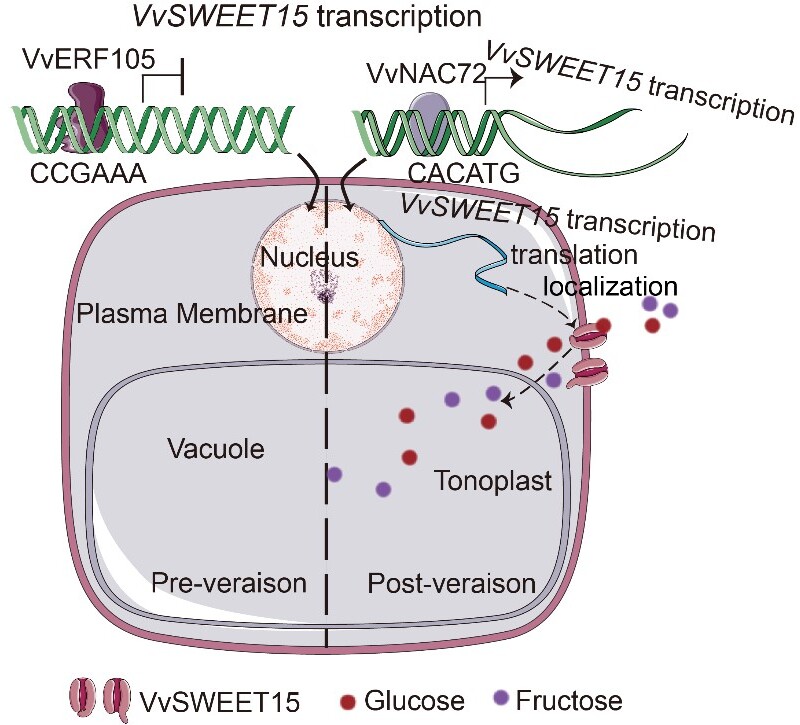
A research group led by Prof. LIANG Zhenchang from the Institute of Botany of the Chinese Academy of Sciences has uncovered two transcription factors, VvERF105 and VvNAC72, that dynamically regulate the expression of a hexose transporter, VvSWEET15. This regulation plays a crucial role in promoting hexose accumulation at different developmental stages in grape berries.
The results of this study were published in The Plant Cell on December 18, 2024.
In fleshy fruits such as grapes, apples, pears, and tomatoes, sugar accumulation occurs primarily through an apoplasmic pathway. Sugar transporters are critical in efficiently transferring sugars from the phloem sap into sink organs during the phloem unloading process, facilitating growth, energy storage, and metabolism. This mechanism is essential not only for plant productivity but also for the plants' capacity to act as carbon sinks.
In grapevines (Vitis vinifera L.), VvSWEET15 gene is strongly expressed during berry ripening. However, the specific functions of VvSWEET15 and the mechanisms regulating its transcriptional have remain poorly understood.
This study focused on understanding how VvSWEET15 contributes to sugar accumulation, particularly during the véraison stage, when hexose accumulation rapidly increases.
The researchers identified VvERF105 as a repressor that binds to the LTR-binding element in the promoter of VvSWEET15. In contrast, VvNAC72 functions as an activator, binding to the CACATG domain in the VvSWEET15 promoter to upregulate its expression and promote hexose accumulation during the post-véraison stages. Both transcription factors and VvSWEET15 are preferentially expressed in phloem cells, underscoring the crucial balance between activator and repressor functions.
Validation studies in grape berries and tomatoes showed VvSWEET15 over-expression boosts hexose levels, suggesting its potential for enhancing sugar content in other crops. Additionally, treatment with external glucose and fructose was found to increase VvSWEET15 expression, implying a feedback loop that optimizes sugar accumulation.
Interestingly, the study also revealed that while SWEET homologs in other plants, such as Arabidopsis, rice, and citrus, primarily transport sucrose, VvSWEET15 specifically transports hexoses in grapes. This highlights the functional diversification of the SWEET gene family across species.
This study contributes to a better understanding of the mechanisms regulating sugar accumulation in grape berries and offer potential insights into the transcriptional regulation and transport mechanisms of VvSWEET15.
This understanding could pave the way for developing strategies to manipulate ripening processes, with potentially significant implications for the grape and wine industry. Additionally, it holds broader relevance for other fruit crops and offer avenues for breeding varieties with optimized sugar content.

Proposed regulatory model for the inhibition or facilitation of hexose accumulation in grape berries. (Image by LU Lizhen)

86-10-68597521 (day)
86-10-68597289 (night)

52 Sanlihe Rd., Xicheng District,
Beijing, China (100864)

